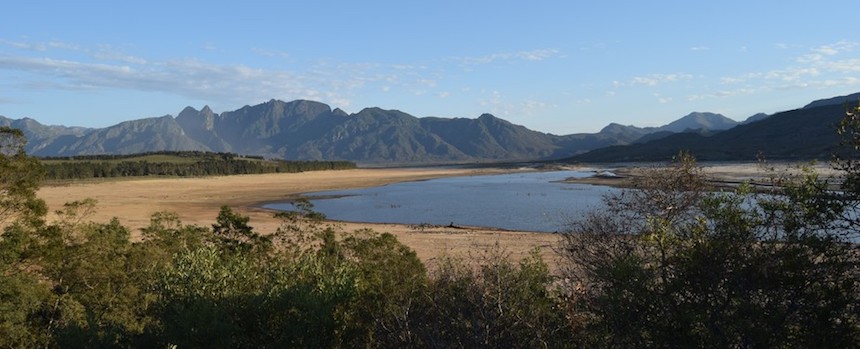 In pre-colonial times the Khoisan called Cape Town, //Hui !Gaeb, the place “where clouds gather” and Camissa “the place of sweet waters”. The future of the city will be shaped by water as it was in the past. But far more attention will need to be paid to the drivers and early warning signs.
In pre-colonial times the Khoisan called Cape Town, //Hui !Gaeb, the place “where clouds gather” and Camissa “the place of sweet waters”. The future of the city will be shaped by water as it was in the past. But far more attention will need to be paid to the drivers and early warning signs.
The city has been experiencing well below average rainfall over the last two-and-a-half years resulting in limited recharge of its main storage dams. The Western Cape region has been declared a disaster area amid a prolonged drought.
Rainfall over the next six weeks will be crucial. Cape Town has a Mediterranean climate with rains falling in the winter months. If there are no major thunderstorms and no significant interventions to bolster supplies from alternate sources such as local aquifers, treated effluent or desalination, then the city could run out of water by the end of year, or in early 2018.
Cape Town is almost entirely dependent on surface water from six main storage dams. Despite population growth and increased demand for water, it has successfully used water demand management over the past 17 years to conserve water by fixing leaks, reducing water pressures, educating users and restricting outdoor water use. But on their own these steps are unlikely to be adequate to avert “day zero”. Alternate water supplies need to be added.
There are two things that Cape Town needs to get right: firstly, it must improve its early warning systems. That is easier said than done. The current drought arrived at a speed and without a confident warning from the scientific community. And, secondly, it must diversify its water supply and become less reliant on surface water supplies.
Early warning systems are not enough
Early warning signs of a pending drought in 2017 were not clear or loud enough to prompt timely actions. As a result, the city was caught relatively unaware. Perhaps the success of the water demand programme created a false sense of security.
Citizens, businesses, officials and politicians responded slowly to early warnings about potential shortages. This is for a number of reasons. Water is taken for granted; there are too many confusing messages about how to manage water; and there is general apathy to adapt to water scarcity because it doesn’t seem to be a priority until it’s in short supply.
Lessons from the 1996 to mid-2010 Australian Millennial Drought show that threat of drought was clearly understood following several severe droughts. Despite the experience, central government was only able to act once the risk became extreme. But then it acted swiftly, investing heavily in new technologies and infrastructure.
This meant substantial increases in the unit cost of water. But Australians understood, and accepted them.
Australians also learnt that there are no quick fixes. They are still working on new interventions and education 10 years after the drought ended.
The City of Cape Town is following a similar trend by investigating new technologies. But these will take time to implement and deliver water in sufficient volume to rescue the city from disaster. In the meantime, saving water is the only game in town in the hope that it will buy the city sufficient time until the next winter rainfall in 2018.
What should be done?
Drivers of water resources are like the cogs in a mechanical system. They turn slowly – some more so than others. Often they fail to attract political will or financial attention because water management is competing with other priorities and demands.
The immediate imperative is to ensure that Cape Town has sufficient water to serve 4 million people with a collective demand of at least 500 million litres per day. It will involve significant investment in alternative water supplies like stormwater, groundwater, seawater or treated wastewater for non-potable use.
But investment to alleviate the crisis must be carefully managed. Emergency spending can restart further crises which in turn could lead to installing new technologies that can’t be used because they are inappropriate or not affordable.
The long term plans need to focus on “climate proofing” the city to ensure that it becomes a water sensitive city. These plans should include treating the city as a catchment where water is collected naturally. Water should be captured and stored in rain tanks, detention ponds, in recharged groundwater and floodplains.
Plans should also include bringing new life to the city’s waterways and regenerating natural systems. This is about rethinking the value of springs, rivers and streams. These blue and green corridors are water sources as well as valuable in reducing urban temperatures.
The city must ensure it has proper plans in place that anticipate future events, such as prolonged changes in weather patterns, so that it can respond quickly. This must include being able to unlock investments and establishing private and government partnerships.
![]() In addition, this drought is setting the conditions for the “new normal” in which citizens will need to become skilled at adapting to a sustainable threshold of water use.
In addition, this drought is setting the conditions for the “new normal” in which citizens will need to become skilled at adapting to a sustainable threshold of water use.
Kevin Winter, Senior Lecturer in Environmental & Geographical Science, University of Cape Town
This article was originally published on The Conversation. Read the original article.

